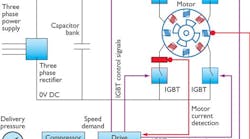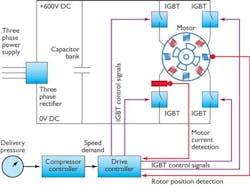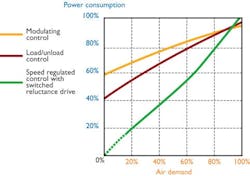In the case of load/unload, the opening and closing of a valve fitted to the intake of the compression control element controls the compressor's output. The valve has only two operating positions: fully open or fully closed. When the valve is open, the compressor delivers full output. When closed, it delivers zero output. To produce 70% output, the compressor operates loaded 70% of the time and unloaded 30% of the time. The drawback is that when the compressor is unloaded, the main motor and cooling fan are still rotating and consuming 20% to 40% of full power. Eliminating unloaded operation can save energy.
Figure 1. Switched reluctance drive motor directly coupled to a rotary screw compression element.
Modulating
With modulating or throttling control, a valve at the air intake of the compression element regulates the output from the compressor. However unlike load/unload control, system pressure controls the valve position, which throttles the entering air. This intake throttling reduces the amount of air passing through the compression element; therby varying the compressor output to meet system demand. The drawback is that as the output is throttled, the intake pressure drops, and the compression element must work harder to achieve the required discharge pressure. The increase in pressure ratio requires more power. To produce 70 percent output, the compressor consumes approximately 85% of full power. One advantage, however, with modulating control is that it reduces discharge air pressure fluctuations.
In any case, both control methods are inefficient when the average air demand is less than 90% to 95% of the compressor output.
Motor limitations
An additional drawback with conventional compressors driven by a fixed-speed ac induction motor is that the motor itself limits compressor operation. Unloading the compressor starts a timer. Provided there is no demand for air, the motor stops only when the timer has cycled. The timer usually is set for a 10-minute run-on time, which allows the motor to cool and puts a physical limit on the number of motor starts per hour. So for a 10-minute run-on, only six starts per hour are permitted, and for each 10-minute run-on period, the motor is consuming 20% to 40% of full power.
Surveys show that the majority of compressor systems operate between 50% and 80% of compressor output with 100% output being required only for short periods. As a result, many systems operate inefficiently, with long periods of unloaded or throttled operation. The ideal solution to this energy-wasting problem is to design the compressor to match output to the system requirements, producing only the amount of air needed at any specific time.
Matching supply to demand
One solution is a regulated variable-speed drive that attempts to maintain a maximum efficiency relationship between air demand and energy consumption, thus keeping energy costs in proportion to the amount of air supplied. A variable-speed drive uses the system pressure as a reference and compares this with the programmed operating pressure. If system pressure is less than the set point, the drive increases the motor speed to deliver more air. An advantage of this system is that delivery pressure can be regulated within two psi of the programmed pressure, thus eliminating over-pressurization.
The switched reluctance (SR) drive (see Figure 1) suits the needs of rotary screw compressors. It follows the variable-speed route, but not by using a frequency inverter or an ac induction motor. The drive uses high-current transistors controlled by a microprocessor to switch on a dc supply to the SR motor stator windings.
The switched reluctance, two-phase dc motor is driven by switching current between the A phase and B phase stator windings. The phases are connected to two sets of four stator windings. In the broadest sense, repetitive switching of current to the windings produces a magnetic field, causing the steel-laminated rotor to rotate. The available motor torque regulates motor speed, which, in turn, is controlled by the current applied to the windings. The current is controlled by the motor's drive electronics via the switching transistors, which limit the current by adjusting the time the windings are energized (see Figure 2). The microprocessor's absolute control over the on/off switching of current going to the motor's windings achieves maximum energy transfer.
The electronics
Figure 2. Switched reluctance drive system with two pairs of transistors (IGBT) that are switched on/off to provide current pulses to the drive motor.
A typical switched reluctance motor in a compressor operates at speeds between 500 rpm and 5,000 rpm while maintaining optimum efficiency, which peaks at about 93%. At maximum output, it equals, rather than improves on, the efficiency of a conventional motor. But many compressors spend their working lives operating below maximum output. That's when the SR drive demonstrates its energy saving potential (see Figure 3).
The motor is smaller than an equivalent ac induction unit, and it can be started and stopped repeatedly, runs cooler and is quieter. In addition, the motor starts and accelerates in a smoothly controlled manner. Inrush current never exceeds the full load running current. The absence of motor heating allows the compressor to start and stop as many times as required.
Compared to a conventional single-speed compressor, a switched reluctance drive compressor operating at an average 70% demand achieves a 25% energy saving, which is derived from eliminating unloaded running and over-pressurization and a better match between air output and demand.
Charting the difference
Figure 3. Comparison of rotary screw compressor regulation systems.
Cost of ownership versus cost of purchase
A common argument against a variable speed drive compressor is its higher initial cost. However, a more realistic comparison can be made when considering the annual cost of ownership during a 10-year period. With a typical oil-lubricated, rotary screw compressor operating at 70% average load, energy costs account for 82% of the cost of ownership. That figure falls to 62% with a switched reluctance drive compressor. Initial purchase price for a switched reluctance compressor represents 12% of the total cost of ownership as opposed to 10% for the conventional fixed speed version, but maintenance and service stands at five percent compared to eight percent. In all, that represents a 21% saving on the annual cost of ownershipthe majority of which is energy cost. The installation of a speed-regulated, variable-speed drive compressor therefore makes sense if reducing compressed air generation costs are a priority.
Gavin Monn is president of CompAir, Sidney, Ohio.
Figures: CompAir



